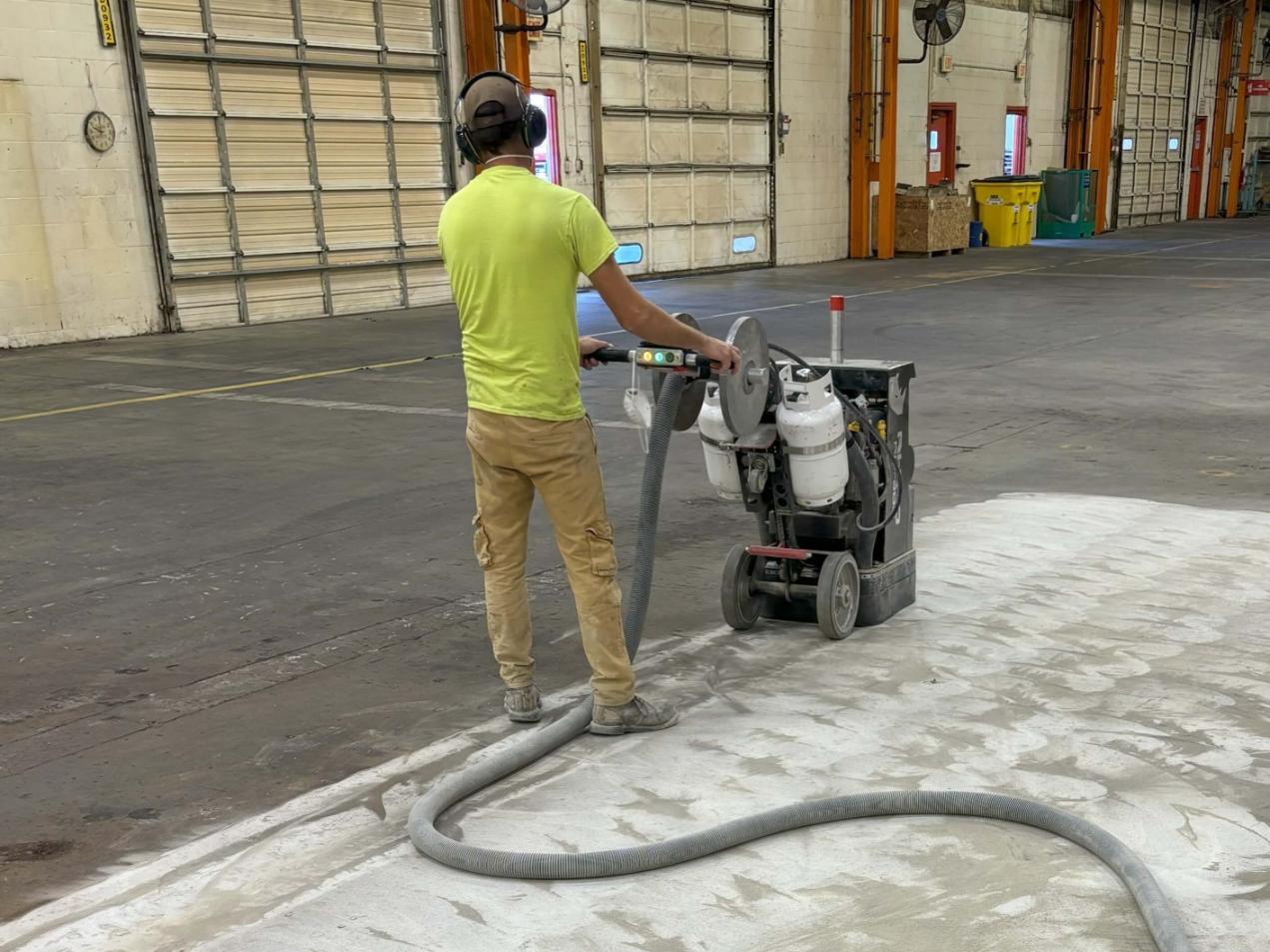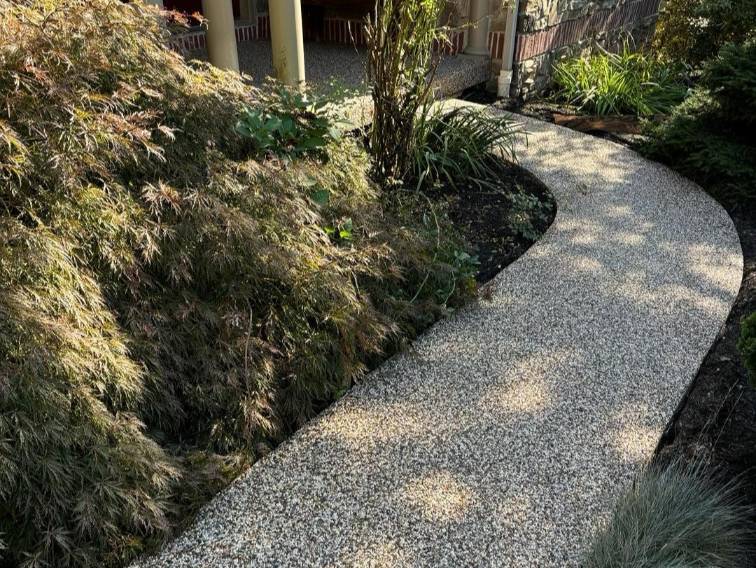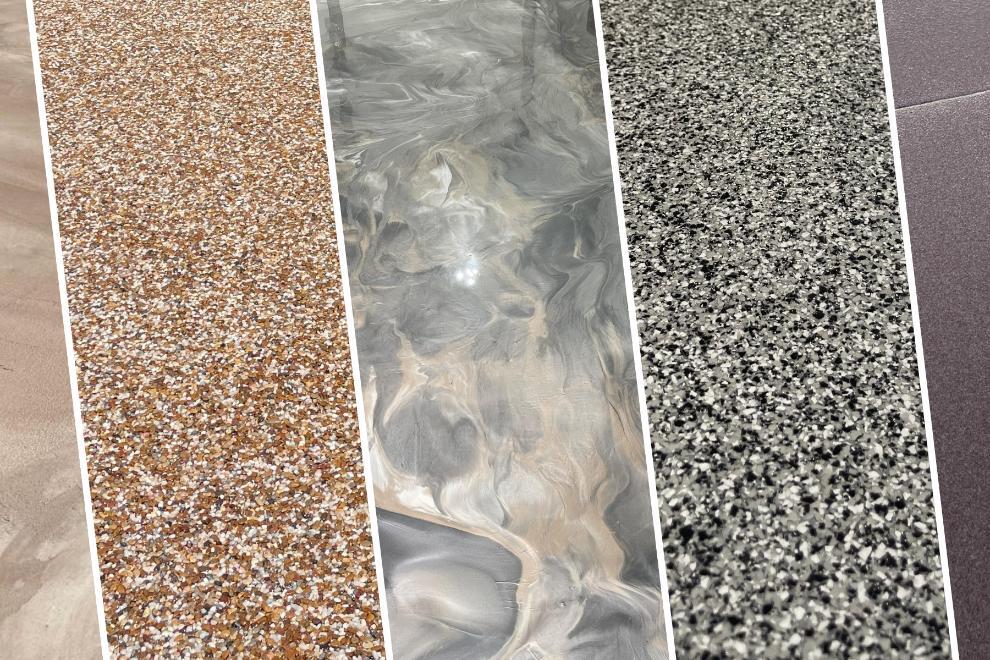If you want an epoxy floor, the concrete has to be prepped first. No matter what coating you want or how old your concrete is, epoxy won't adhere well without properly prepared concrete. Every floor coating business offers a different method for prepping the concrete. What is the best way to prep a floor for an epoxy coating?
Elite Floor Coatings has coated over two million square feet of concrete. Our team takes concrete prep seriously. Proper prep and cleanup significantly impact the quality of the finished epoxy product.
When you've finished reading, you'll know how our team preps concrete for epoxy coating. You'll also understand situations where concrete needs extra prep work and whether this can be replicated at home.
All Concrete Gets Prepped The Same Way.
There's a common misconception that new concrete doesn't need to be prepped for an epoxy coating. In reality, even new concrete will have a chalkiness on the surface that isn't very strong. This chalkiness must be removed.
All concrete, whether it was just poured or is hundreds of years old, must be prepped for an epoxy coating. And in most cases, the prep is the same.
Prep Begins With A Diamond-Tooled Grinder.
The first step in preparing the concrete is using a walk-behind grinder. These grinders can range in size, but the commercial equipment is quite large. These machines use diamonds to grind away the surface of the concrete.
.jpg?width=533&height=400&name=800%20Pound%20Grinder%20Machine%20(Greencastle).jpg)
A significant portion of the concrete dust is cleaned up beneath the machine as it runs. Protective dust shrouds and vacuums keep the dust out of the air.
How much concrete is removed with the grinder depends on the state of the concrete. In most cases, an eighth of an inch is taken off the top. With more damage, the equipment may grind off more.
Prepping the concrete is necessary not only for adhesion but also for leveling the floors. Any high points of the concrete can be removed during this grinding process.
After Grinding, Prep Continues With A Shot Blasting Machine.
While these professional grinders clean off contaminants and find weak spots, they create a significant amount of dust and chalkiness. Next, we vacuum the floor with special concrete vacuums, but even those vacuums don't clean enough. The best method for cleaning up this leftover dust is a shot-blasting machine.
Using a shot-blasting machine allows you to capture all of the dust. This method doesn't leave any chalkiness or dust behind.
Shop vacs are sometimes recommended in place of shot-blasting machines. However, a shop vac cannot pick up all the residue the grinder leaves.
Another common recommendation is a floor scrubber for cleaning. A floor scrubber is arguably worse than a shop vac. Floor scrubbers create a slurry out of concrete dust and water, which doesn't truly clean the floor. This type of equipment also prevents you from proceeding with your epoxy work on the same day. You cannot install epoxy on wet concrete.
Once The Concrete Is Clean, It’s Time For Repairs.
Now that the concrete has been ground, leveled, and cleaned, any damage to the concrete can be addressed.

Major repairs are done with epoxy mortar, which sets very quickly. Cracks can also be filled with epoxy gels. These gels are similar to drywall compound, but come as a paste. One other option for repairing concrete is polyjacking, which can address areas where the concrete has sunken or is not level.
In most cases, the epoxy coating can continue the same day after these repairs.
Sometimes, Concrete Needs Special Preparation.
The previous section addressed standard concrete prep. However, there are special circumstances that can change how the concrete needs to be prepped.
Let's take a look at some instances where prep work looks different.
Oil Staining Means More Grinding.
If the concrete has oil stains, we usually grind below the stains. Prepping techniques and grinding alone can generally get below the oil stains. However, there are cases where the oil has stained deep into the concrete. If removing a reasonable layer of concrete doesn't eliminate the stain, the epoxy floor will begin with a special primer. This primer will prevent oil from causing adhesion problems with the epoxy.
Pitting Means Filling Holes With Pastes.
After grinding, concrete floors sometimes still have pitting. We cannot leave the floor bumpy, especially for certain types of epoxy coatings, where the smoothness of the concrete beneath determines the smoothness of the top coat surface.
.jpg?width=300&height=400&name=Pitting%20Before%20(Chambersburg).jpg)
If the pitting is shallow, we can use an epoxy paste for repairs. However, more aggressive pitting needs a different approach. We use a mixture of sand and epoxy. The process is similar to finishing drywall seams.
.jpg?width=300&height=400&name=Pitting%20After%20(Chambersburg).jpg)
Weakness Means Patches.
Sometimes, concrete is hollow or weak. The weakness of a slab of concrete becomes evident during grinding. The grinder indicates the strength of the concrete via sound. We know when a slab has weaknesses that need to be addressed.
Before installing any coating, we patch weak concrete. These patches are ugly, but they are also very strong. These concrete patches stick to concrete more than concrete sticks to itself. It doesn't matter how ugly the concrete patches are; they get covered with an aesthetic epoxy floor coating.
Garages Need Garage Door Termination Cuts.
Garages are one of the most popular areas for epoxy floor coatings. Epoxy is an opportunity to refresh an otherwise drab space with a pop of color. However, the functionality of the garage door presents a unique challenge.
We don’t epoxy garage aprons, which is the area outside of the garage door where the concrete meets the blacktop. We also don’t epoxy under the garage door, so we can close the door to protect the epoxy floors while they cure.
Termination cuts are necessary to create a proper termination point. We don’t end our coatings at the edge where the concrete meets the blacktop, because there is no good anchor point. Without a termination cut, moisture can creep under the coating and tires and wear on the corners, among other issues.
It's best practice to create termination cuts, which stop right before the garage door. This termination cut creates a clear stopping point for the epoxy, which prevents it from lifting or flaking.
Proper Equipment Is Not Available For Rent.
You may want to reconsider if you've been thinking of doing your epoxy work yourself. One significant reason to not do DIY epoxy is your lack of access to professional equipment. These diamond-tooled grinders are not available to rent. If you find comparable equipment or a shot-blasting machine to rent, the rental price will be quite high.
.jpg?width=534&height=400&name=1500%20Pound%20Grinder%20Machine%20(Somerset).jpg)
Properly prepping your concrete is hard and expensive. Even if you could match professional-grade epoxy work with box kits, it wouldn't be any more affordable if you accessed the right tools to prep the concrete.
Not All Professionals Use Appropriate Prep Equipment.
While we don't encourage DIY epoxy work for several reasons, we also want to caution you against trusting any epoxy flooring professional. Not every business that installs epoxy uses the appropriate equipment to prep the concrete. Many companies use shop vacs instead of shot-blasting machines.
If you want an epoxy coating that will last, you'll want to work with a qualified epoxy professional.
What You Need To Know About Epoxy Floor Prep
Prepping concrete for an epoxy coating is vital to ensure proper adhesion. All concrete, new and old, must be prepared for epoxy. In most cases, the prep work follows a three-step grind, clean, and repair process. Some concrete needs unique repairs or prep to ensure the longevity of the epoxy floor.
Prepping a slab of concrete for epoxy is not something that can be done on your own. It's also essential to find a qualified installer who does prepare the concrete correctly.
Want to learn more about epoxy floors? Check out these resources next.
.png?width=1800&height=528&name=Elite%20Floor%20Coatings%20Header%20Logo%20With%20White%20Background%20(1).png)




.jpg)
